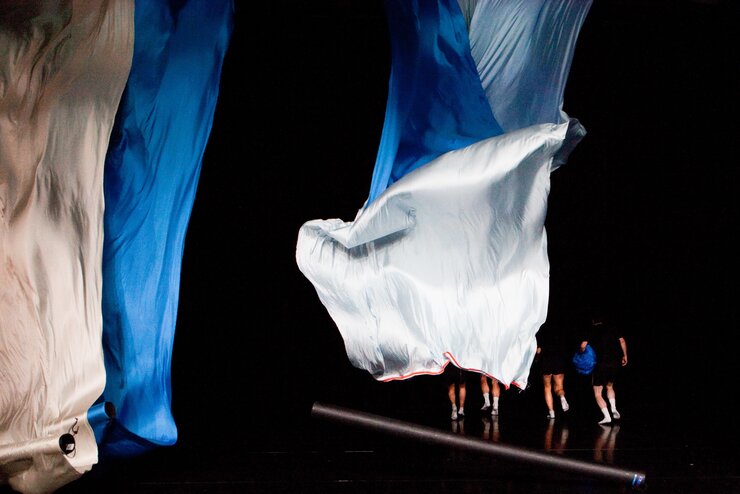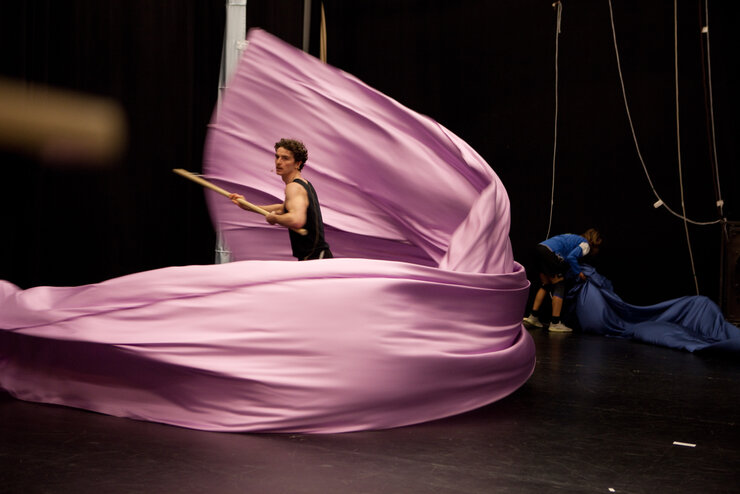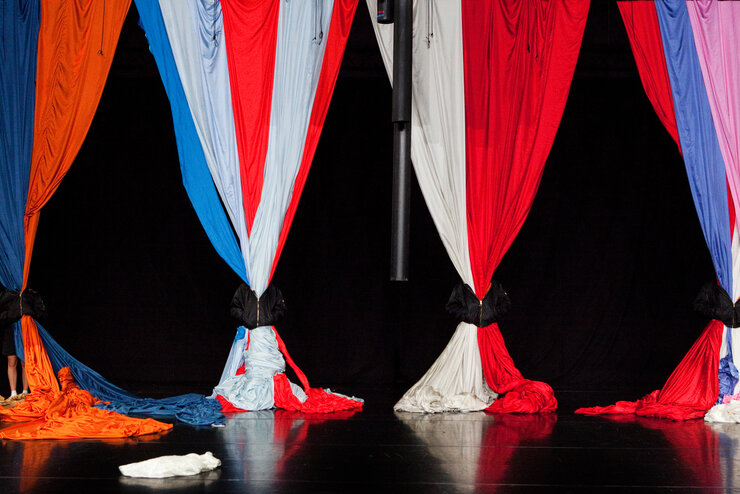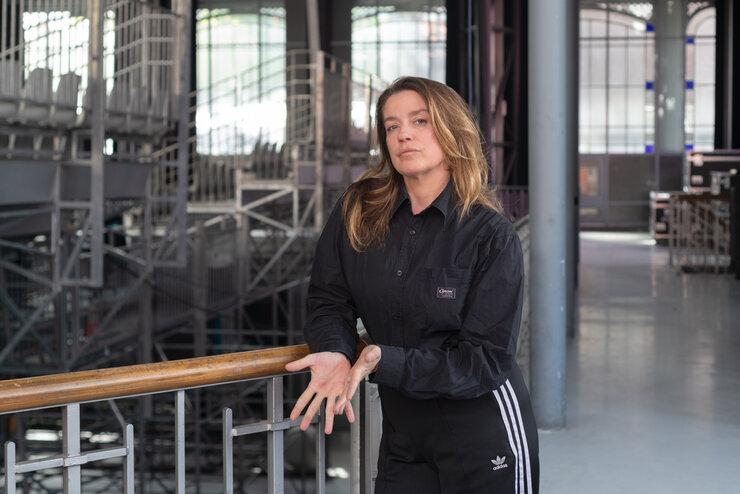Miet Warlop, born in Torhout, Belgium, in 1976, is a performance and visual artist. Warlop studied at the KASK Royal Academy of Fine Arts in Ghent. Her performances, actions and interventions have been shown at Campo, the Flemish-Dutch Theatre Festival, the Kunstenfestivaldesarts and the Beursschouwburg Brussels, among others. Her works have been featured at many European festivals. She was a guest at the Zurich Theater Spektakel in 2023 with «One Song» and returns this year with «INHALE DELIRIUM EXHALE». In 2026, Warlop will design the Belgian pavilion at the Venice Art Biennale. In conversation with Matthias von Hartz, artistic director of the Zurich Theater Spektakel, Miet Warlop talks about the complex rehearsal process, the pitfalls of the material – and she also reveals a few secrets...
Miet, thank you for taking the time to talk about your new project «INHALE DELIRIUM EXHALE», which will be on stage at the Zürcher Theater Spektakel this August. I think the first time we spoke about it was maybe two years ago, and we’ve had several conversations since. I’ve always wanted to ask you: is there usually a single starting point for your pieces – a place where it all begins?
Actually, I wouldn’t say there’s always a single starting point, because my shows are quite different from one another. But what they do have in common is that I try to find a foundation – some kind of material I really believe in. Something that creates a frame I can work within. That was exactly the challenge with «INHALE DELIRIUM EXHALE». It began as a sort of menu of different images I wanted to present.
It was the first time I didn’t have a clear frame – just a sequence of disconnected images. So this piece really forced me to confront what it means to work without one.
Usually, I spend a couple of years just living and creating on the side – and only afterwards do I decide to make a piece, to reflect on that time. But this one feels more like a direct portrait. I genuinely didn’t know what it would become.
So I let go of much of the original «menu» of images and decided to focus on the material itself – this ungraspable, ambiguous quality. And then something else began to emerge during the process: we were constantly in contact with the fabric – caressing it, rolling it, folding it, dropping it, placing it back on the grid. It became a circular, shared activity. We followed the human rhythm of the performers. They wanted to do their job well – to give each moment the space it needed to really be seen.
What I’ve realised now is that the rhythm is not actually set by the performers – it’s set by the technicians who drop the fabric. That’s much closer to what I was really after: you don’t see the performers appear – you see them disappear. You come forward with the fabric, and then you vanish. It’s not just about standing in front holding fabric – it’s about disappearing.
That search took a long time. And it was also technically complex. Now I feel the piece really communicates what I meant. It’s no longer about the kind of entertainment I usually offer – unless you count the fact that the fabrics are fucking huge. It works more through volume than through entertainment. And it’s not funny. It’s only funny because it’s impossible to grasp.
You said you usually set yourself a kind of frame – and that this time was different. In earlier works, you often used objects. Would you say that objects are part of how you create that frame?
No, it’s more like a desire. It’s hard to put into words… But for example, in «Dragging the Bone», I had this urge to make a sculpture live, in front of the audience. Or I wanted to do exercises while singing, performing – trying to translate a feeling into a body or an object. That feeling we all try to describe but can never quite grasp – we try to give it a shape, an image. With «One Song», that probably came the closest: feeling, image, music, energy – all aligned. That’s why it worked. That’s also how we know something works. In «One Song», the people are as big as their energy. You only see it crack at the very end. But «INHALE DELIRIUM EXHALE» isn’t like that. Here, the performer is smaller than the clothes.
And yes, it’s always a question for me – what do I understand, or want to understand? And it’s also a question I put to the audience: Okay, I have this. Do you have this too? I’ve seen people in here. Are you also there? That kind of exchange. Not personal, exactly – more like checking in: Is this something we all feel? Or am I the only one carrying this mess of life – or the beautiful stuff?
When you’re alone on stage, and everything has turned to stone, or taken on a body, you think: We’re just a big heap of stuff. And then it’s like – okay, is everyone just a heap of stuff? I’m sure we are.

When you said it’s a very honest piece I really connected with that. Because, for me, the images I saw felt like they were reflecting the turmoil we’re all living through right now.
Yeah.
And when you talked about the fabric – flexible, ungraspable, always shifting – that really struck me as contemporary.
It’s good to feel things fall, and not resolve in the end. Not all cleaned up and dynamised. No – just there. We don’t know what to do with it. We just know it’s a lot. And it’s there. It keeps coming, and we catch it. But we can’t give it a place. We don’t have an overview. We’re locked in. And we’re not visible – not at this moment.
We’re sitting under a fat layer of media telling us a lot, but we can’t say anything back. Even if we post «Gaza Gaza Gaza» every day – it doesn’t matter. They’ll still turn that coastline into a new Dubai. That’s how they see it.
And I’m not just talking about war – I’m talking about what’s in your head.
That’s why the yoga scene – go back to the mat, calm down, take a breath, «OM» – feels increasingly irritating. Even the «OM», that symbol of peace, just doesn’t land anymore.
I imagine it must be really difficult to rehearse a piece like this. I mean, if you drop a huge amount of silk, you can’t just reset the scene like in a conventional rehearsal. It probably takes hours just to roll it back up – right?
That’s what I said at the beginning: coming out of this cycle of preparing and trying, and preparing and trying – it involved things like rolling the fabric, feeling every centimetre go through your hands, then feeling it drop on your head. So the preparation became something very sensitive. I actually wanted to integrate that roll-up into the piece. But then it would have lasted four hours. And sometimes I regret not doing that. It was just a choice, like: okay, either we go for one hour – image after image – you just run through it, or we let it unfold slowly, as the fabric comes and goes. But I thought this wasn’t the context for that. Because I think everything we did with «INHALE DELIRIUM EXHALE» is actually an amazing twelve-hour piece.
I still think there are contexts – like in a museum – where you can take that kind of time. But once you're on a theatre stage, facing an audience, you have to make your conversation understandable in a short time. I’ve never made a piece longer than one hour. Except that one time in «One Song», where we all got stuck in a loop and it ended up being one hour fifteen. But never before.
You know, it’s strange – we spent so much time caressing silk. Rolling and caressing, over and over again. That was part of the piece, too. But it made the audience wait so long for the next image that we eventually cut it out.
You could honestly do another whole show called «THE MAKING OF INHALE DELIRIUM EXHALE»
I could definitely make a great film out of it – no question. Every video I shot during rehearsals looked incredible. You can get in close, adjust the timing, really focus on the material. So yes, I definitely want to do something video-based with it. It has this inherently cinematic quality.

When I first thought about the state of delirium, I always imagined it as something blurry, kind of inactive. Then I saw the show. And it’s not blurry. Not at all. In a way, it’s actually very clear. I don’t mean clear as in: «Here’s the message.» But the images—they’re very precise, I think. And very active. But I remember you said you weren’t ready or happy at the premiere?
That premiere... it was so slow. Twenty minutes of waiting – imagine: twenty minutes of just waiting. But in a strange way, it was a good experience. To sit there thinking: Oh my God. And then I saw in my dad’s eyes some kind of joy – like: «Wow, you dared to not be ready. That’s cool.» I really appreciated that, because it was exactly how it felt. I had to carry it. Because it was insane.
My shrink once told me: «You know, your way of fixing things is always by putting more shoulder under it. More pressure. More energy. More people. Bigger. Louder. Stronger.» And I said: «Yeah, that’s true.» And she replied: «Maybe you could try looking at things without always doing that.» So I did. I tried. I wasn’t sure if it was good advice – but at least I gave it a go. And it really was a completely different experience. I didn’t use my force in this piece. But I definitely used something else: my patience. My being. Just being – like everyone else – in this lake of things we don’t understand, trying to make sense of it, and simply trying to stay calm. Maybe that sounds a bit pathetic. But still – there’s also strength in that.
Is there a relationship between «One Song» and «INHALE DELIRIUM EXHALE»?
«One Song» is really a core piece for me. Somehow, every element is there. And then, like a seed, parts of it grow into something else – a transformer, a place you can travel from into other spaces.
I imagined that the five people on the fan tribune in «One Song» – the ones always shouting, «Hey? Hey?» – were the ones who step into the image of «INHALE DELIRIUM EXHALE». They’re shouting because the performers on stage have just burned out in front of them – but they keep going: «Hey! Hey! Hey!»
That really helped me. Because I’m not a pro-project kind of person – I work with the body. And suddenly, just knowing that those five people existed in my imagination made everything click. It made it make sense. Because if you look at my work, «INHALE DELIRIUM EXHALE» is actually quite abstract.
Yeah, but I like that. For me, it resonates with what I’m experiencing right now. Things feel less clear – and embarrassingly out in the open. I mean, things are happening that, two years ago, you’d never have imagined. And suddenly, they’re out in the open – and no one intervenes.
Exactly.

One last, completely different question: Can you share anything about Venice, where you’ll be representing Belgium at the Biennale pavilion? Or is there a pact of secrecy with the State of Belgium?
No, no, no – no secrecy. There are some elements we already know will come together, but it’s also something new. A new kind of «home», you could say. This time, I’ll be working with plaster. That actually started with a piece I did in Bangladesh – that’s what got me into it. There’s this idea of a chant or a shout, of chanting words, a demonstration, or trying to connect by using these short, circular, two-letter words – to arrive at something shared. That’s the starting point for the pavilion: this attempt to connect.
So the work will combine live music and sculpture – it’s like a sculptural poem that’s performed. But it’s not performed by performers; it’s live music and a live installation. The body installs the stone lyrics – and then we go. I’m really looking forward to it. I’m excited.
Credits
Interview: Matthias von Hartz
The interview was conducted in English.
Translation into German: Franziska Henner
Portrait photo: Bea Borgers
Photos from INHALE DELIRIUM EXHALE: Reinout Hiel
